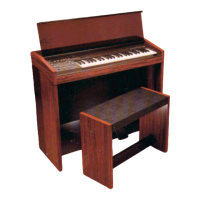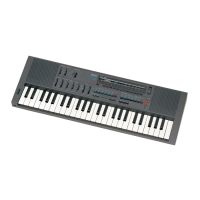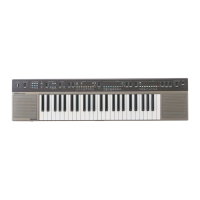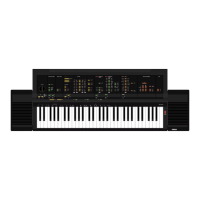Reference Voice Mode
Voice Edit mode Drum Voice Edit Key Edit
203
Owner’s Manual
Category Determines the Category of the Wave/Normal Voice. If you switch to another Category, the first Wave/Normal Voice in
that Category will be selected.
n For more information about the Categories, refer to the separate Data List booklet.
[SF2] OUTPUT
From this display you can set certain output parameters for the selected Drum key.
InsEFOut
(Insertion Effect Output)
Determines which Insertion effect (A or B) is used to process each individual Drum key. The “thru” setting lets you
bypass the Insertion effects for the specific key.
Settings: thru, insA (Insertion Effect A), insB (Insertion Effect B)
RevSend (Reverb Send) Determines the level of the Drum key sound (the bypassed signal) that is sent to Reverb effect. A setting of “0”
results in no Reverb processing of the Drum key sound. This is available only when Insertion Effect Output (above) is
set to “thru.”
Settings: 0 ~ 127
ChoSend (Chorus Send) Determines the level of the Drum key sound (the bypassed signal) that is sent to Chorus effect. A setting of “0”
results in no Chorus processing of the Drum key sound. This is available only when Insertion Effect Output (above) is
set to “thru.”
Settings: 0 ~ 127
OutputSel (Output Select) Determines the specific output(s) for the individual Drum key signal. You can assign each individual Drum key sound
to be output from a specific hardware output jack on the rear panel. This is available only when Insertion Effect
Output (above) is set to “thru.”
Settings: See page 31.
[SF5] OTHER
From this display you can set various parameters related to how the individual notes of the Drum voice respond to
the keyboard and MIDI data.
AssignMode When this is set to “single,” double playback of the same note is prevented. This is useful when two or more
instances of the same note are received nearly simultaneously, or without a corresponding note off message. To
allow playback of each instance of the same note, set this to “multi.”
Settings: single, multi
RcvNoteOff (Receive Note Off) Determines whether or not the selected Drum key responds to MIDI Note Off messages.
Settings: off, on
n This parameter is available when the Type is set to “pre wav” or “usr wav” in the [F1] OSC → [SF1] WAVE display (page 202).
AlternateGroup Set the Alternate Group to which the key is assigned. In a real drum kit, some drum sounds cannot physically be
played simultaneously, such as open and closed hi-hats.You can prevent keys from playing back simultaneously by
assigning them to the same Alternate Group. Up to 127 Alternate Groups can be defined. You can also select “off”
here if you wish to allow the simultaneous playback of sounds.
Settings: off, 1 ~ 127
[F2] PITCH
[SF1] TUNE
From this display you can set various pitch-related parameters for the selected key.
Coarse Determines the pitch of each Drum Key Wave (or Normal Voice) in semitones.
Settings: -48 ~ +48
n
If a Normal voice has been assigned to the key, this parameter adjusts the position of its note (not its pitch) relative to note C3.
Fine Determines the fine tuning for the pitch of each Drum Key Wave (or Normal Voice).
Settings: -64 ~ +63
[SF2] VEL SENS
(Velocity Sensitivity)
Pitch Determines how the pitch of the selected Drum key responds to velocity. For positive values, the more strongly you
play the key, the higher the pitch becomes. For negative values, the more strongly you play the key, the lower the
pitch.
Settings: -64 ~ +63
[F3] FILTER
[SF1] CUTOFF
This synthesizer lets you apply a low pass filter and high pass filter to each individual Drum key — giving you
exceptionally detailed and comprehensive sonic control over the Drum voice.
Settings: This parameter is available when the Type is set to “pre wav” or “usr wav” in the [F1] OSC → [SF1] WAVE display (page 202).
LPFCutoff Determines the Cutoff frequency of the Low Pass Filter.
Settings: 0 ~ 255
LPFReso Determines the amount of Resonance (harmonic emphasis) applied to the signal at the Cutoff frequency.
Settings: 0 ~ 127
HPFCutoff Determines the Cutoff frequency of the High Pass Filter.
Settings: 0 ~ 255

